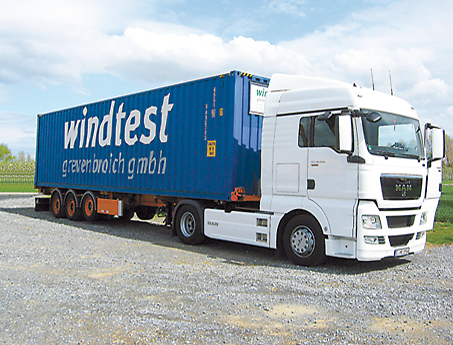Grid Integration + Power Quality

Prototype Measurement
Again and again the grid compatibility of wind energy is a subject of discussion among energy experts. Frequently they mention the security of supply, which must be guaranteed if wind energy systems (WES) are integrated into the grid.
Benefit to the Customer
The measurement of the electrical characteristics according to the FGW's Technische Richtlinie (Technical Directive, part 3 and 4) or IEC 61400-21 is required by the distribution network and power grid operators for calculations required for the connection to their networks. Basically, it must be guaranteed that the connection of new WES to the grid and the public supply network does not interfere with other customer systems and equipment. The measurement of the WES' electrical characteristics determines whether the WES comply with the limit values.
In order to connect the WES as required, the potential system perturbation is tested before the WES' start-up.
Here limit values and compatibility levels apply that can be found in the grid codes and conditions of the various network operators.
What is measured?
- Output Characteristics
As a rule, current and voltage are measured. Based on these measurements, the apparent, the idle and the effective power can be calculated across different information periods. Additionally, it is possible to determine the power factor or the cosine φ. - Flicker
For the type test a current-related flicker measurement is carried out. The measured current is converted to an imaginary node, and the existing flicker in the network is also calculated. In addition, a voltage-related flicker measurement can be carried out. - Harmonics
In addition to the measurement of harmonics of current and voltage to the 50th order, intermediate harmonics and frequency content of more than 2.5 kHz are determined. - Voltage Changes
Voltage changes in the grid are caused by switching operations in the WES. In order to determine this voltage change for any connection point, the current is recorded during these switching operations and converted to an imaginary node.
LVRT Measurements
- Grid Protection / Grid Connection Codes
In order to test the grid protection system of a WES, the voltage increase and decrease protection and the frequency increase and decrease protection are tested. During recent years many national and international grid operators have published Grid Codes. In accordance with these regulations, wind parks must demonstrate certain capabilities of the idle power control and the output limitation. Furthermore, wind parks must demonstrate certain behaviours in case of grid malfunctions that actively support the stability of the grid. Corresponding measurement regulations have been developed by the FGW ("FGW Directive", part 4), in co-operation with windtest grevenbroich gmbh.In co-operation with the FGH (Forschungsgemeinschaft für Elektrische Anlagen und Stromwirtschaft e.V./Research Foundation for Electrical Installations and Power Industry), the performance of WES in case of malfunctions, so-called short-circuit or LVRT measurements, is tested. Here wtg creates concepts for the measurement and certification of WES according to the applicable grid codes and makes the required testing units and measuring systems available to the customer for short-circuit trials
This service offering applies equally to tests of other local energy generation systems, such as biomass power plants, combined heat and power plants or photovoltaic installations. Additionally, the service offering of wtg includes voltage monitoring according to EN 50 160, power flow and grid simulation and calculation of output losses.
Our competence:
- FGW conformity seal for grid compatibility measurements of WES,
- Accredited according to ISO 17025 for measurements of grid compatibility,
- Co-operation in the Fachausschuss Netzverträglichkeit und Netzanschluss (Technical Committee for Grid Compatibility and Grid Connection) of the FGW on the Technische Richtlinie für Windenergieanlagen Teil 3 und 4 (Technical Directive for Wind Energy Systems, Part 3 and 4),
- Co-operation in research groups and events, e.g. with the FGW, VDN etc., on the subject of grid connection.
We carry out all these measurements according to the international and national directives.



